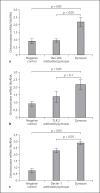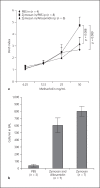Chitinase-Induced Airway Hyperreactivity and Inflammation in a Mouse Model of Nonallergic Asthma
- PMID: 33730726
- PMCID: PMC8315691
- DOI: 10.1159/000513296
Chitinase-Induced Airway Hyperreactivity and Inflammation in a Mouse Model of Nonallergic Asthma
Abstract
Introduction: Environmental exposure to mites and fungi has been proposed to critically contribute to the development of IgE-mediated asthma. A common denominator of such organisms is chitin. Human chitinases have been reported to be upregulated by interleukin-13 secreted in the context of Th2-type immune responses and to induce asthma. We assessed whether chitin-containing components induced chitinases in an innate immune-dependent way and whether this results in bronchial hyperresponsiveness.
Materials and methods: Monocyte/macrophage cell lines were stimulated with chitin-containing or bacterial components in vitro. Chitinase activity in the supernatant and the expression of the chitotriosidase gene were measured by enzyme assay and quantitative PCR, respectively. Non-sensitized mice were stimulated with chitin-containing components intranasally, and a chitinase inhibitor was administered intraperitoneally. As markers for inflammation leukocytes were counted in the bronchoalveolar lavage (BAL) fluid, and airway hyperresponsiveness was assessed via methacholine challenge.
Results: We found both whole chitin-containing dust mites as well as the fungal cell wall component zymosan A but not endotoxin-induced chitinase activity and chitotriosidase gene expression in vitro. The intranasal application of zymosan A into mice led to the induction of chitinase activity in the BAL fluid and to bronchial hyperresponsiveness, which could be reduced by applying the chitinase inhibitor allosamidin.
Discussion: We propose that environmental exposure to mites and fungi leads to the induction of chitinase, which in turn favors the development of bronchial hyperreactivity in an IgE-independent manner.
Keywords: Airway inflammation; Chitinase; Fungi; Innate immune system; Mites.
© 2021 The Author(s) Published by S. Karger AG, Basel.
Conflict of interest statement
Dr. Christina Weber-Chrysochoou received honoraria for being part of an advisory board of Takeda and for a talk at CSL Bering. All other authors have no conflicts of interest to declare.
Figures




References
-
- Garden FL, Simpson JM, Marks GB, Investigators C. Atopy phenotypes in the Childhood Asthma Prevention Study (CAPS) cohort and the relationship with allergic disease: clinical mechanisms in allergic disease. Clin Exp Allergy. 2013 Jun;43((6)):633–41. - PubMed
-
- Matricardi PM, Illi S, Grüber C, Keil T, Nickel R, Wahn U, et al. Wheezing in childhood: incidence, longitudinal patterns and factors predicting persistence. Eur Respir J. 2008 Sep;32((3)):585–92. - PubMed
-
- Lau S, Illi S, Sommerfeld C, Niggemann B, Bergmann R, von Mutius E, et al. Early exposure to house-dust mite and cat allergens and development of childhood asthma: a cohort study. Multicentre Allergy Study Group. Lancet. 2000 Oct 21;356((9239)):1392–7. - PubMed
-
- Illi S, von Mutius E, Lau S, Niggemann B, Grüber C, Wahn U, et al. Perennial allergen sensitisation early in life and chronic asthma in children: a birth cohort study. Lancet. 2006 Aug 26;368((9537)):763–70. - PubMed
Publication types
MeSH terms
Substances
LinkOut - more resources
Full Text Sources
Other Literature Sources
Medical
Research Materials

